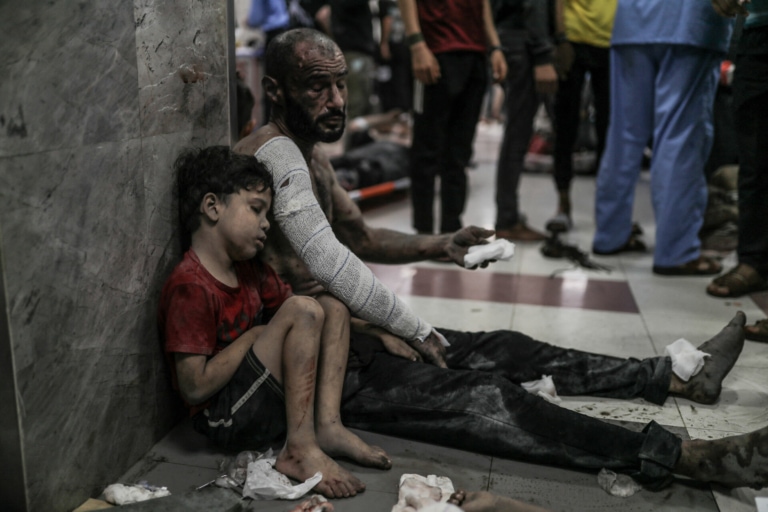
According to Palestinian authorities, more than 8,000 people, including at least 3,000 children, have lost their lives in aerial bombardments in the Gaza Strip in recent weeks.
Israeli F-35 fighter jets with Danish military equipment participate in the bombings.
This is the conclusion of a review of the Israeli military’s social media, local news media and press releases from the Israeli government, conducted by Danwatch and Information.
The Israeli Defence Forces (IDF) confirms the participation of fighter jets in the war:
“We can confirm that the F-35s have been operating in the Gaza Strip throughout this operation, i.e. the war against Hamas that started on 7 October,” an IDF spokesperson told Danwatch.
Among other things, the Israeli F-35 fighter jets are equipped with so-called pylons, produced by the Danish defence company Terma. The pylons are positioned underneath the aircraft wings and are used to hold and launch bombs and missiles.
The Israeli air strikes in Gaza were launched after the militant Hamas movement carried out a terrorist attack in Israel on Saturday 7 October, killing more than 1,400 people and taking more than 200 hostages.
Israel then began a bombing campaign against alleged Hamas targets in Gaza, which has so far claimed the lives of more than 8,000 people.
The Israeli military spokesperson does not want to elaborate on exactly what role the Danish-equipped fighter jets play in the war against Hamas, but he tells Danwatch that the Israeli Defence Forces (IDF) is doing “everything they can” to avoid civilian casualties.
According to Save the Children, more children have been killed in Gaza in recent weeks than were killed in armed conflicts worldwide in the whole of 2022.
Denmark has signed both EU rules and a UN treaty on arms exports. This means that Denmark must reject the export if there is a “clear risk” that the military equipment exported from Denmark will be used for war crimes or other violations of international law.
Marc Schack, Associate Professor of International Law at the University of Copenhagen, warns that Denmark risks breaking the rules by exporting parts for the Israeli fighter jets.
“There are now very serious allegations that Israel is committing war crimes, and the gravity of the situation emphasises that Denmark is taking a legal risk by allowing the export of weapons parts to a country where it is well known that there are challenges in complying with the laws of war,” says Marc Schack.
Zeray Yihdego, Professor of International Law at the University of Aberdeen in Scotland, agrees. He is one of Europe’s leading experts on arms control legislation.
“Although the current war has been instigated by Hamas and includes serious violations of international law, any response to such a criminal act must be within the framework of the law,” emphasises Zeray Yihdego.
He believes that the ongoing bombardment of Gaza is very worrying.
“While we don’t have concrete facts about every single Israeli military action, what we see in media reports and on TV screens raises serious questions about proportionality and compliance with the duty to protect civilians in armed conflict,” he says.
According to the Scottish expert, the apparent lack of protection of civilian lives means that Denmark risks violating the international laws and regulations on military exports, to which it has committed itself.
“Modern international law prohibits complicity in international wrongdoing. More specifically, both the UN Arms Treaty and EU rules prohibit the supply of conventional arms, ammunition, parts and components to a recipient if there is a risk that they will be used in violation of international humanitarian law and international human rights norms,” says the professor.

Both international human rights organisations and UN experts believe that clear war crimes have been committed during the Israeli bombardment of the Gaza Strip.
One of them is Human Rights Watch, which emphasises that both Hamas and Israel have committed possible war crimes.
Several of Israel’s aerial bombardments, which have destroyed entire residential blocks and also hit hospitals, risk violating the laws of war, and thus the planes with Danish equipment may risk being complicit in war crimes, says Omar Shakir, Israel and Palestine director at Human Rights Watch.
“If the F-35 fighter jets have been operating in the Gaza Strip since 7 October 2023, there is certainly a risk that they will be used in connection with possible war crimes,” Omar Shakir told Danwatch and Information.
Amnesty International has investigated several of the specific Israeli air strikes carried out in the first days of the war. Days that included the participation of Danish-equipped F-35 fighter jets.
Amnesty also emphasises that the killing of civilians by both Hamas and the Israeli military during the current war is a violation of the rules of war.
In a report released on 20 October, Amnesty International presents what it describes as “compelling evidence” that the Israeli Air Force’s bombing of residential buildings, a refugee camp, a family home and a market between 7 and 12 October violated the laws of war and its obligation to protect civilians.
The investigated air strikes include the bombing of a three-floor residential building that killed fifteen members of a family – including seven children. According to witnesses, the bomb hit without any prior warning and without Amnesty International being able to find any indications of military targets.
Another attack destroyed a six-floor building and killed at least 40 civilians. According to Amnesty International’s investigation, a Hamas member was living on one of the floors, but he was not at home when the building was destroyed. And even if he had been at home, that alone would not make the building a legitimate target, Amnesty emphasises in the report.
“Our investigation points to compelling evidence of war crimes in Israel’s bombing operations that should be investigated immediately,” Amnesty writes.
The Israeli Defence Forces (IDF) rejects the report’s conclusions.
“The Amnesty International report is flawed, biased and premature, and based on unfounded assumptions about IDF operations,” an IDF spokesperson wrote in a written comment to Danwatch and Information.
The IDF writes that the Israeli military is taking “all possible precautions under the circumstances” to minimise harm to civilians, including warnings to civilians “whenever possible”. The IDF also emphasises that the Israeli military has repeatedly used social media and leaflets to call on civilians to evacuate to the southern part of the Gaza Strip.
“The IDF regrets any harm to civilians caused by our operations, and we examine all our operations to learn, improve and ensure that all activities were conducted in accordance with operational procedures and the law,” the IDF spokesperson writes.

Terma, Denmark’s largest defence company, has 700 employees involved in the production of parts for the American-made F-35 fighter jets, of which Israel has 36. There are six essential parts from Terma on every F-35 aircraft.
In addition to the pylons that hold and release the aircraft’s external bombs and missiles, Terma also supplies radar components, machine parts and parts for the aircraft’s tail. All parts are essential for the functioning of the aircraft
Danwatch has asked Terma how the company’s management responds to the fact that the aircraft are now being used in the bombardment of Gaza, where human rights organisations believe that serious war crimes are being committed.
In an email response, Kasper Hyllested, Head of Communications at Terma, writes that the company has all necessary export licenses and complies with all relevant legislation.
“Terma produces and supplies parts for the F-35 programme. All these parts are covered by the thorough Danish export controlsThis means that the Danish authorities – the Danish National Police, the Ministry of Foreign Affairs and others – have thoroughly assessed our exports and granted us a license,” he writes.
“At Terma, we are pleased and proud to be part of the F-35 programme – and thereby make a significant contribution to Denmark’s important alliance with the United States and other countries. Danish industry’s participation in the F-35 programme , which is the world’s largest industrial project, creates growth and many good Danish jobs”, writes the Head of Communications in the email to Danwatch.
No posts
As Danwatch and Information have previously described, Danish authorities have for decades deliberately failed to assess the risk of Danish fighter jet exports being used for human rights violations when the aircraft end up in controversial countries such as Israel.
It has been known since 2010 that Israel is the recipient of the F-35 aircraft, which Israel has been involved in developing since 2003.
The Danish practice is in direct conflict with both the UN Arms Treaty and EU rules on arms exports, several legal experts have previously told Danwatch and Information.
Both sets of rules require Denmark to always assess the risk of human rights violations and war crimes at the end user when Danish defence companies export military equipment to controversial countries.
Even though the Danish aircraft parts are formally exported to the aircraft factory in the US, Denmark must assess the risk with the final buyer, i.e. Israel, experts say.
Danwatch has asked Foreign Minister Lars Løkke Rasmussen (M) about the risk of Danish aircraft exports being used for war crimes in Gaza.
The Minister of Foreign Affairs has not answered this question, but in an email, the Ministry of Foreign Affairs confirms that Danish licences for the export of parts for the F-35 aircraft usually only involve an assessment of the risk of misuse in the United States:
“In relation to the F-35, the export controls in Denmark usually only take place with the United States as the recipient, as it is usually not known at the time of application whether and, if so, to where the finished product with the relevant subcomponents may be resold,” says the Ministry of Foreign Affairs.
“Any subsequent export of the finished product will be subject to U.S. export controls, which include considerations of human rights, international humanitarian law and regional stability,” the ministry writes.
The Israeli Air Force currently has a total of 36 F-35 aircraft with Danish parts, with another 14 aircraft on the way. In addition, in July this year, US aircraft manufacturer Lockheed Martin, which produces the F-35 fighter jets, received an order for a further 25 F-35 aircraft for Israel.
These aircraft will also contain Danish parts and components.